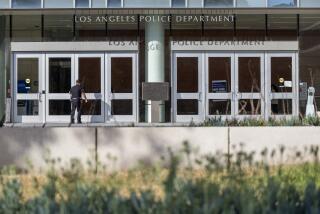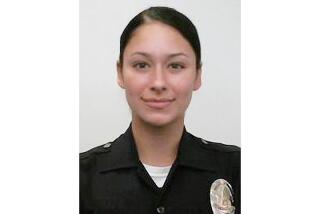Jury convicts LAPD officer for kicking woman in groin

Mary O’Callaghan stands after the reading of the verdict for her trial at the Clara Shortridge Foltz Criminal Justice Center on June 5.
- Share via
The camera captured the Los Angeles police officer hissing a cruel threat at the handcuffed woman, striking at her throat with an open hand and kicking her in the crotch.
The video of the arrest, recorded by a patrol-car camera, persuaded jurors to convict Officer Mary O’Callaghan on Friday of assault under color of authority.
During the two-week trial, in which the defense argued that O’Callaghan hadn’t used excessive force, the video gave jurors an unvarnished view of what happened, one said.
“It played a big role,” said Deedra Garcia, the jury forewoman. “It gave us a lot of evidence.”
In a crowded courtroom Friday, O’Callaghan, 50, rested her head in her hands and her attorney rubbed small circles on her back. A relative of Alesia Thomas, the 35-year-old mother assaulted by O’Callaghan who lost consciousness in the back seat of the patrol car and died soon later, tapped her left foot over and over. The jurors — 11 women and one man — walked to their seats.
When a clerk read the guilty verdict, O’Callaghan whispered to her attorney and gave him a hug. Her face reddened and her eyes filled with tears. She noticed a bailiff standing behind her and swooped her hands behind her back, holding them in two fists — a position she had, for years, commanded arrestees to assume. The courtroom fell silent and the handcuffs clicked four times as they closed around her wrists.
Reached by phone after the verdict, Phillip Washington — the father of Thomas’ youngest daughter — said the 2012 death devastated the family, especially his daughter, who was 3 when her mother died. He couldn’t attend the court proceeding Friday because his daughter felt sick, but he praised the verdict.
“I’m hoping the outcome of this is that the system will change,” he said.
A statement released by Benjamin Crump, a civil rights attorney representing the family, called the conviction one step toward justice for Thomas’ children.
“Our family prays,” the statement reads, “that the unedited video will be released soon.”
The prosecution’s case centered on the video, which showed O’Callaghan jab at Thomas’ throat with an open hand and threaten to break her arms and kick her in the crotch. In the video, O’Callaghan then raises her boot and strikes Thomas, whose body shakes in response.
The recording captured Thomas — who asked officers for an ambulance more than 30 minutes before one was called — breathing heavily and repeatedly saying, “I can’t.”
A video from a dashboard camera in another patrol car, which was also played during the trial, recorded O’Callaghan laughing and smoking a cigarette as she peeked inside the car at Thomas, whose legs were tied with a nylon hobble restraint.
“That ain’t a good sign,” O’Callaghan says out loud in the video.
Assistant Head Deputy Dist. Atty. Shannon Presby told jurors that O’Callaghan was “immune from any empathy” and that the video clearly showed the officer kicking Thomas in the crotch and the stomach.
But O’Callaghan’s attorney, Robert Rico, disagreed, telling jurors that the recording instead showed his client pushing Thomas with her boot.
Rico told jurors that although the footage showed an “ugly” scene, his client’s use of force was “reasonable, justified and necessary.” Thomas wasn’t complying with the officers’ orders, he said.
The attorney played an audio clip, which he said showed O’Callaghan didn’t want to hurt Thomas, for the jurors.
“If you want to kill me, just kill me,” Thomas says in the recording.
“I don’t want to kill you,” O’Callaghan responds. “I just want to transport you.”
“Why?” Thomas asks.
“To get you some help,” the officer says in the recording.
After the verdict, Rico said he planned to file a motion for a new trial, saying he believed jurors had based their decision on emotions — and his client’s profanity captured on camera — not on evidence. Rico described O’Callaghan as far from callous, saying she often bought Halloween costumes and Christmas presents for children in local housing projects.
“Mary O’Callaghan is today — and was — the type of officer that goes above and beyond, not only for her fellow officers but also for the community,” Rico said.
Thomas was pronounced dead at a hospital after her July 22, 2012, arrest, which came after officers arrived at her home to investigate claims that she had abandoned her two children by dropping them off at a police station.
Washington, the father of Thomas’ daughter, said he thought Thomas acted responsibly, adding that she had dropped the children off at the station with clothes and a note. His daughter, he said, still doesn’t know how Thomas died.
“She was too young then to understand,” he said. “I’m waiting for her to have questions of her own.”
O’Callaghan, who did not testify in the trial, was not charged in connection with Thomas’ death.
An autopsy by the Los Angeles County coroner determined that cocaine intoxication was probably a “major factor” in Thomas’ death. It wasn’t possible to determine what role, if any, the struggle with O’Callaghan or other officers who took part in the arrest played in it. The official cause of death was listed as “undetermined.”
O’Callaghan is one of three Los Angeles Police Department officers charged with assault under the color of authority for on-duty incidents captured on camera. In April, Officer Richard Garcia, 34, was charged with using unlawful force during an arrest in South L.A. Officer Jonathan Lai, 31, was charged last year with using excessive force while detaining a man near Staples Center in 2012.
Police Chief Charlie Beck said in a statement Friday that patrol car cameras, when used appropriately, “can help ensure that officers who operate outside of the law, and tarnish our badge, are held accountable.”
Times staff writers Kate Mather and James Queally and columnist Sandy Banks contributed to this report.
For more news from the Los Angeles County criminal courts, follow @marisagerber
More to Read
Sign up for Essential California
The most important California stories and recommendations in your inbox every morning.
You may occasionally receive promotional content from the Los Angeles Times.












